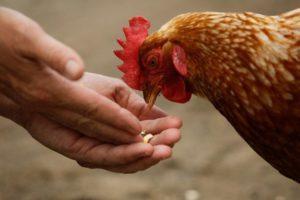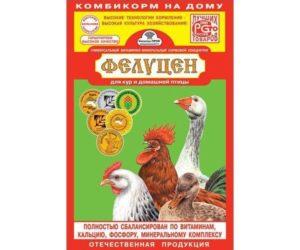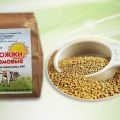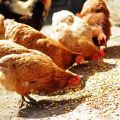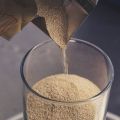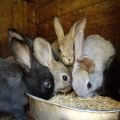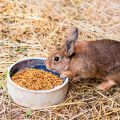How to properly give yeast to chickens at home
Poultry feed does not always increase bird productivity. Owners of the poultry farm are trying to enrich the pet diet with a variety of food additives. One of the most used additives is yeast. They are included in compound feeds and regular foods for hens. To avoid unpleasant consequences, you should know how to properly give yeast to chickens, in what volume.
What is yeast?
Yeast - saturation of feed with nutrients, which improves the appetite of birds, and increases their productivity. Yeast mushrooms are added to the main food mixture, then the fermentation process takes place. The result is a food with increased nutritional value, rich in vitamins and phytoinsulin.
The feed obtained as a result of yeast bran, grain mass, meat and bone meal provides chickens with the necessary amount of protein and mineral elements in winter.
Birds that receive such nutrition grow actively and fully, and the volume of muscle tissue and tendons corresponds to the size of the body.

Benefits and disadvantages
Yeast is a rich source of proteins, fatty acids, trace elements necessary for the body - both chicken and adult poultry. With the regular inclusion of yeast feeding in the diet of chickens:
- fertility increases (in the winter months, chickens produce 23% more eggs);
- the appetite of pets improves;
- strengthens the immune system;
- body weight is growing;
- the diameter of the eggs becomes larger.
However, some chickens develop a negative reaction to feed with yeast:
- diarrhea;
- inflammation of the cloaca;
- gregarious cannibalism;
- inflammatory pathologies of the joints.
A host who notices these symptoms should interrupt the yeast feeding or reduce the concentration of the product in the feed by 50%.

Yeast methods
First, the food mass should be crushed. Moreover, the smaller the resulting fraction, the better. Yeast is carried out in three ways:
- sponge;
- unpaired;
- sourdough.
The optimum temperature for the water used is 36-38 ° C. You cannot heat it higher, otherwise the fungus will die. For cooking, you need to take more than half the volume of the prepared feed, as it will swell during fermentation. The yeast must be dissolved well so that no lumps remain. You can speed up the dissolution by adding a spoonful of sugar.
Dough method
The preparation of the feed is stage-by-stage: first, the dough is kneaded, then yeast is performed.
For dough, take 200 g of grain base, 10 g of yeast (they are diluted in 0.5 liters of slightly warmed up water). The mixture is set aside for 4 hours. Add another 800 g of grain, pour in a liter of water. After 4 hours of infusion, the feed is used.

Without dough
For cooking, take 1 kg of grain base, 0.2 g of yeast, 1.5 liters of heated water. A mixture of grain and yeast is made, set aside for 6-hour fermentation. Stir regularly during this time. If the food is swollen so that it has absorbed all the liquid, then you need to pour in a glass of water.
Sourdough method
Combine 10 g of yeast and 0.5 liters of heated water. The mixture is poured into 0.5 kg of grain. Leave to swell for 6 hours. Another 0.5 kg of grain is poured in, 0.8 liters of water are poured in, stir well. A day later, the feed is used for its intended purpose.

What is included in yeast mash?
A mixture of only one grain with yeast does not provide the bird's body with the necessary amount of beneficial compounds.
The grain base is a source of carbohydrates. Whole grains are less nutritious and may be better ground or flattened. During the winter months, the best option is to germinate the grains, so the birds get the maximum amount of vitamins.
To make the feed more nutritious, chopped hay, vegetables, berries, low-fat milk and fermented milk products, bran, vegetable oil, and meat are added to it.

For broilers
For the full growth of muscle mass, it is necessary that the amount of protein in the feed is from 22%.
An option for a daily menu for a broiler who has reached 2 months of age:
- crushed wheat, barley, corn grain (100 g);
- sunflower cake (15 g);
- boiled potatoes (40 g);
- yeast (20 g);
- salt (1 g).

For laying hens
Layers' diets are less protein-rich, but more fortified.
Option for the winter daily diet of the layer:
- crushed wheat, barley, corn grain (70 g);
- wheat bran (20 g);
- a mixture of boiled potatoes, fresh carrots, pumpkin in equal proportions (20 g);
- powdered grass (5 g);
- yeast (20 g);
- salt (1 g).
It is advisable to enrich the feed with chalk during the winter months. This substance supplies the body with calcium, which is important for the formation of hard-shell eggs.

For turkeys
Broiler turkey poults are actively growing, their body requires food rich in protein and carbohydrates. It is impossible to prepare food suitable for such breeds on your own. Young birds use quality store food that is suitable for them. To make the meat tastier, you can add fresh grass, fermented milk products to the main food.
Birds of light to medium weight are less picky about their diet. For them, you can prepare a mixture:
- chopped wheat, corn, pea mass (60%);
- grass, vegetables (20%);
- yeast (20%).

How to give feed yeast to chickens correctly?
Give every day or every other day. The optimal daily amount is 20 g of product per individual.
Feed yeast should be included in the diet of birds from mid-autumn to mid-spring. In the warmer months, chickens eat a lot of fresh food, so they do not need yeast feeding.
The shelf life of homemade food does not exceed a day. If a lot has been cooked, and it is a pity to throw it away, then you can freeze the unused part, but after defrosting it will be less useful.
How much baker's yeast to give grown poultry?
Baker's yeast is suitable for feeding chickens. They are not included in the dry food mass, but yeast is produced by the methods described above.
The daily portion of feed for one individual is 20 g. It is advisable to give the first dose not more than 12 g. Then it is increased to the norm in two weeks. The frequency of feeding with baker's yeast is 2 or 3 times a week.
When can yeast be added to chicken feed?
Chicks can consume yeast-rich feed from 18 days of age. Daily portion - 3-4 g.
Broiler chickens are more in need of protein foods. They can consume yeast as early as day 15.The initial portion is 3 g, then it increases to 10 g.
Special methods of feed preparation
For the yeast to be more effective, the grain must be prepared for the process:
- Grind. Grain grains with a diameter of up to 3 mm are better absorbed, give more nutrients. The fermentation process of the crushed grain is faster.
- Pour boiling water over. The starch in the grains is converted into sugar, the nutrient base for the fungus.

To make your food more nutritious, you can follow these guidelines:
- add cereal sprouts rich in useful compounds (5 g per individual);
- use warm whey rich in minerals and protein instead of water;
- add chopped zucchini, potatoes, beets as sources of vitamins.
Feed yeast is a good way to increase the nutritional value and digestibility of grain for chickens. This feed helps hens to improve performance during the winter months and helps broilers gain weight. Yeast is more profitable than buying artificial vitamin supplements, fish and meat meal.
